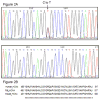A novel mutation in the HCN4 gene causes symptomatic sinus bradycardia in Moroccan Jews
- PMID: 20662977
- PMCID: PMC3005590
- DOI: 10.1111/j.1540-8167.2010.01844.x
A novel mutation in the HCN4 gene causes symptomatic sinus bradycardia in Moroccan Jews
Abstract
Objectives: to conduct a clinical, genetic, and functional analysis of 3 unrelated families with familial sinus bradycardia (FSB).
Background: mutations in the hyperpolarization-activated nucleotide-gated channel (HCN4) are known to be associated with FSB.
Methods and results: three males of Moroccan Jewish descent were hospitalized: 1 survived an out-of-hospital cardiac arrest and 2 presented with weakness and presyncopal events. All 3 had significant sinus bradycardia, also found in other first-degree relatives, with a segregation suggesting autosomal-dominant inheritance. All had normal response to exercise and normal heart structure. Sequencing of the HCN4 gene in all patients revealed a C to T transition at nucleotide position 1,454, which resulted in an alanine to valine change (A485V) in the ion channel pore found in most of their bradycardiac relatives, but not in 150 controls. Functional expression of the mutated ion channel in Xenopus oocytes and in human embryonic kidney 293 cells revealed profoundly reduced function and synthesis of the mutant channel compared to wild-type.
Conclusions: we describe a new mutation in the HCN4 gene causing symptomatic FSB in 3 unrelated individuals of similar ethnic background that may indicate unexplained FSB in this ethnic group. This profound functional defect is consistent with the symptomatic phenotype.
Figures





Comment in
-
The slow pace of the heart and the objectives of molecular cardiology.J Cardiovasc Electrophysiol. 2010 Dec;21(12):1373-4. doi: 10.1111/j.1540-8167.2010.01879.x. Epub 2010 Aug 30. J Cardiovasc Electrophysiol. 2010. PMID: 20807277 No abstract available.
Similar articles
-
Point mutation in the HCN4 cardiac ion channel pore affecting synthesis, trafficking, and functional expression is associated with familial asymptomatic sinus bradycardia.Circulation. 2007 Jul 31;116(5):463-70. doi: 10.1161/CIRCULATIONAHA.107.706887. Epub 2007 Jul 23. Circulation. 2007. PMID: 17646576
-
The slow pace of the heart and the objectives of molecular cardiology.J Cardiovasc Electrophysiol. 2010 Dec;21(12):1373-4. doi: 10.1111/j.1540-8167.2010.01879.x. Epub 2010 Aug 30. J Cardiovasc Electrophysiol. 2010. PMID: 20807277 No abstract available.
-
Familial sinus bradycardia associated with a mutation in the cardiac pacemaker channel.N Engl J Med. 2006 Jan 12;354(2):151-7. doi: 10.1056/NEJMoa052475. N Engl J Med. 2006. PMID: 16407510
-
Pacemaker channels and sinus node arrhythmia.Trends Cardiovasc Med. 2004 Jan;14(1):23-8. doi: 10.1016/j.tcm.2003.09.006. Trends Cardiovasc Med. 2004. PMID: 14720471 Review.
-
The Contribution of HCN4 to normal sinus node function in humans and animal models.Pacing Clin Electrophysiol. 2010 Jan;33(1):100-6. doi: 10.1111/j.1540-8159.2009.02563.x. Epub 2009 Oct 1. Pacing Clin Electrophysiol. 2010. PMID: 19796353 Free PMC article. Review.
Cited by
-
Pacemaker Channels and the Chronotropic Response in Health and Disease.Circ Res. 2024 May 10;134(10):1348-1378. doi: 10.1161/CIRCRESAHA.123.323250. Epub 2024 May 9. Circ Res. 2024. PMID: 38723033 Free PMC article. Review.
-
Overview of Basic Mechanisms of Cardiac Arrhythmia.Card Electrophysiol Clin. 2011 Mar 1;3(1):23-45. doi: 10.1016/j.ccep.2010.10.012. Card Electrophysiol Clin. 2011. PMID: 21892379 Free PMC article. No abstract available.
-
Transcription factor ISL1 is essential for pacemaker development and function.J Clin Invest. 2015 Aug 3;125(8):3256-68. doi: 10.1172/JCI68257. Epub 2015 Jul 20. J Clin Invest. 2015. PMID: 26193633 Free PMC article.
-
Pacemaker activity of the human sinoatrial node: an update on the effects of mutations in HCN4 on the hyperpolarization-activated current.Int J Mol Sci. 2015 Jan 29;16(2):3071-94. doi: 10.3390/ijms16023071. Int J Mol Sci. 2015. PMID: 25642760 Free PMC article. Review.
-
Genetics and Sinus Node Dysfunction.J Atr Fibrillation. 2009 Apr 1;1(6):151. doi: 10.4022/jafib.151. eCollection 2009 Apr-May. J Atr Fibrillation. 2009. PMID: 28496616 Free PMC article. Review. No abstract available.
References
-
- DiFrancesco D, Tortora P. Direct activation of cardiac pacemaker channels by intracellular cyclic AMP. Nature. 1991;351:145–147. - PubMed
-
- DiFrancesco D. Pacemaker mechanisms in cardiac tissue. Annu Rev Physiol. 1993;55:455–472. - PubMed
-
- Baruscotti M, Bucchi A, DiFrancesco D. Physiology and pharmacology of the cardiac pacemaker (“funny”) current. Pharmacol Ther. 2005;107:59–79. - PubMed
-
- Ludwig A, Zong X, Jeglitsch M, Hofmann F, Biel M. A family of hyperpolarization-activated mammalian cation channels. Nature. 1998;393(6685):587–91. - PubMed
Publication types
MeSH terms
Substances
Grants and funding
LinkOut - more resources
Full Text Sources
Molecular Biology Databases

